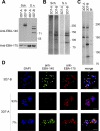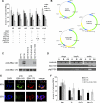Epigenetic silencing of Plasmodium falciparum genes linked to erythrocyte invasion
- PMID: 17676953
- PMCID: PMC1937010
- DOI: 10.1371/journal.ppat.0030107
Epigenetic silencing of Plasmodium falciparum genes linked to erythrocyte invasion
Abstract
The process of erythrocyte invasion by merozoites of Plasmodium falciparum involves multiple steps, including the formation of a moving junction between parasite and host cell, and it is characterised by the redundancy of many of the receptor-ligand interactions involved. Several parasite proteins that interact with erythrocyte receptors or participate in other steps of invasion are encoded by small subtelomerically located gene families of four to seven members. We report here that members of the eba, rhoph1/clag, acbp, and pfRh multigene families exist in either an active or a silenced state. In the case of two members of the rhoph1/clag family, clag3.1 and clag3.2, expression was mutually exclusive. Silencing was clonally transmitted and occurred in the absence of detectable DNA alterations, suggesting that it is epigenetic. This was demonstrated for eba-140. Our data demonstrate that variant or mutually exclusive expression and epigenetic silencing in Plasmodium are not unique to genes such as var, which encode proteins that are exported to the surface of the erythrocyte, but also occur for genes involved in host cell invasion. Clonal variant expression of invasion-related ligands increases the flexibility of the parasite to adapt to its human host.
Conflict of interest statement
Figures








References
-
- Cowman AF, Crabb BS. Invasion of red blood cells by malaria parasites. Cell. 2006;124:755–766. - PubMed
-
- Sim BK, Chitnis CE, Wasniowska K, Hadley TJ, Miller LH. Receptor and ligand domains for invasion of erythrocytes by Plasmodium falciparum . Science. 1994;264:1941–1944. - PubMed
-
- Stubbs J, Simpson KM, Triglia T, Plouffe D, Tonkin CJ, et al. Molecular mechanism for switching of P. falciparum invasion pathways into human erythrocytes. Science. 2005;309:1384–1387. - PubMed
Publication types
MeSH terms
Substances
Grants and funding
LinkOut - more resources
Full Text Sources
Other Literature Sources
Molecular Biology Databases

